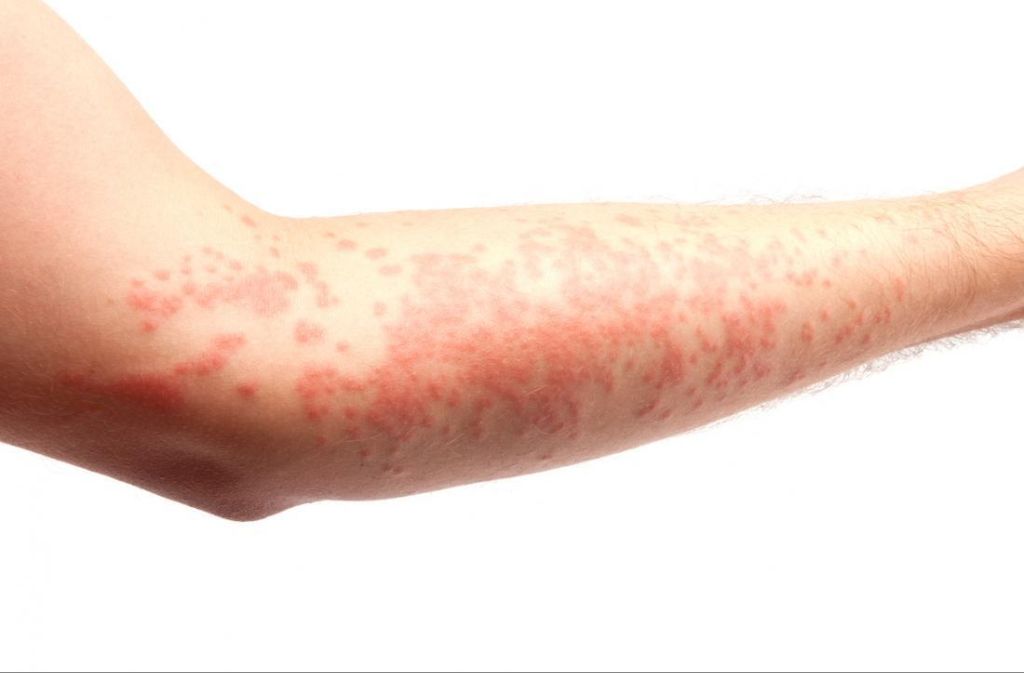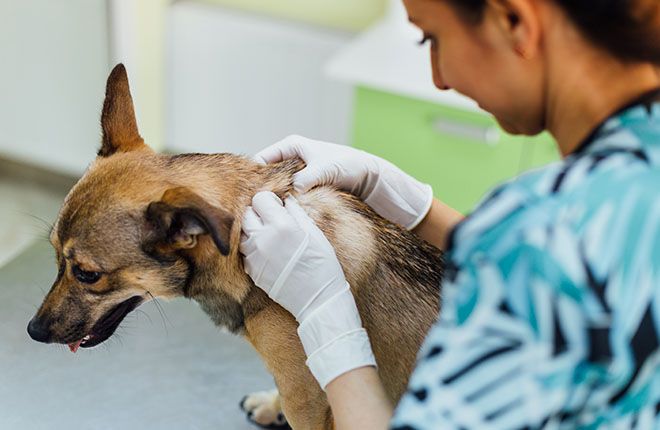Introduction
It can be concerning and confusing when you suddenly develop an itchy rash, also known as hives or urticaria, after contact with your dog. Especially when your dog has been a part of the family for years without issue. While the relationship with your beloved pet remains the same, your immune system may have changed over time, making you more susceptible to allergic reactions from substances in your dog’s dander, saliva, or urine. Fortunately, there are ways to manage this new dog allergy through treatment, prevention strategies, and lifestyle adjustments, so you can continue living happily with your four-legged friend.
What are Hives?
Hives, also known as urticaria, is a skin condition characterized by raised red bumps, welts or wheals on the skin that often itch, swell and turn white in the middle when pressed. Hives can be localized to one part of the body or appear all over.
Hives are a result of the release of histamine and other chemicals from under the skin’s surface. The release of these chemicals causes fluid to leak from the blood vessels, leading to swelling and redness of the skin. The exact cause of hives is often hard to identify, but the condition is frequently triggered by an allergic reaction or contact with an allergen.

Hives can appear suddenly and disappear within hours or persist for longer periods of time. Symptoms typically last less than six weeks. Hives that recur for more than six weeks are known as chronic hives.
Possible Causes
There are several possible reasons why a person may suddenly develop hives from contact with their dog, even if they have not had an issue before. Some of the most common causes include:
Allergies
One of the most likely reasons is the development of a new allergy to the dog. Allergies can form at any age, even if you’ve owned a dog for years with no problems. You may become sensitized to proteins in their saliva, dander, or urine. When these allergens come into contact with your skin, they can trigger an immune system reaction that leads to hives.
Infections
Certain viral, bacterial, or fungal infections have been associated with hives or hive-like rashes. For example, some gastrointestinal infections may cause hives to appear. Skin infections can also result in hives on the surface of the skin. In rare cases, parasites may trigger hives.
Autoimmune Disorders
Autoimmune conditions like lupus and rheumatoid arthritis have been linked to the development of hives and other rash symptoms. With autoimmunity, the immune system mistakenly attacks the body’s own tissues and can cause skin inflammation.
Medications
Allergic reactions to medications are a relatively common cause of hives. Antibiotics, NSAIDs, opioid pain relievers, and blood pressure medications are among the drug classes that most often provoke hives as a side effect. An allergic reaction can develop even if you’ve taken the medication without issue in the past.
Allergic Reaction
In some cases, hives may be caused by an IgE mediated allergic reaction to something in the dog’s environment, food or grooming products. This type of reaction occurs when the immune system produces antibodies called Immunoglobulin E (IgE) in response to an allergen. The IgE antibodies attach to mast cells in the skin, which contain histamine. When the allergens interact with the IgE on mast cells again, it triggers the release of histamine and other inflammatory chemicals that lead to hives and other allergy symptoms.

Common dog allergy triggers include:
- Foods like beef, chicken, wheat, corn, soy
- Flea treatments
- Shampoos or grooming products
- Grass, pollen or mold spores
- Dust mites
Allergic reactions tend to occur within minutes to hours after exposure to the allergen. They can range from mild to life-threatening anaphylaxis.
Risk Factors
Certain factors can increase your risk of developing hives from your dog.
Atopy history: If you have a personal or family history of atopic conditions like asthma, hay fever or eczema, you are more likely to develop hives from your dog. Atopy refers to the genetic tendency to develop allergic conditions.
Age: Hives are more common in younger adults and children. The reasons are unclear but may relate to developing immunity as you age.
Gender: Women are more likely to get hives than men. Fluctuating hormone levels may play a role.
Diagnosis
To diagnose the cause of hives in dogs, the veterinarian will take a detailed medical history and perform diagnostic tests. They will ask about the dog’s health, diet, environment, onset of symptoms, and any changes or events that occurred around the time the hives appeared. This can help identify potential triggers like food allergies, insect bites, medication reactions, or other exposures.
Allergy testing is an important diagnostic tool. The vet may do intradermal skin testing where small amounts of potential allergens are injected under the skin to check for a reaction. Blood tests can also check for elevated allergy antibodies. These tests can identify specific allergens like certain foods, pollens, or dust mites that could be causing the hives. Patch testing may be done by applying potential irritants to the skin to rule them in or out as a cause. Ringing out the dog’s skin with saline can collect cells for microscopic examination to check for infection or parasites that could lead to hives.
Treatment

Treatment for hives depends on identifying and addressing the underlying cause. Some common treatments include:
Antihistamines
Antihistamines like cetirizine (Zyrtec), loratadine (Claritin), or fexofenadine (Allegra) can help relieve itching and swelling from hives. These medications block the release of histamine, which is responsible for the allergic reaction and hives. Antihistamines come in pill form as well as creams that can be applied directly to the skin.
Immunotherapy
If an allergy is suspected, allergy testing can identify the specific allergen. Allergen immunotherapy involves getting allergy shots on a regular basis to desensitize your immune system and build up tolerance to the allergen. Over time, this can significantly reduce allergic reactions and hives.
Avoidance
Avoiding known triggers is key to preventing recurrent hives. If you’ve developed an allergy to your dog, you may need to find them a new home. At minimum, take steps to limit your exposure through washing hands after contact, keeping the dog out of your bedroom, and using HEPA air filters. If your hives stem from a food allergy, strictly avoiding that food will prevent future reactions.
Prevention
There are several things you can do to help prevent getting hives from your dog:

-
Consider getting a hypoallergenic dog breed. Certain breeds like poodles, schnauzers and bichon frises are less likely to trigger allergies and hives.
-
Use HEPA air filters in your home. HEPA filters can remove dander, pollen and other allergens from the air.
-
Wash your dog frequently using a mild, hypoallergenic shampoo. Bathing your dog regularly can reduce allergens on their fur.
-
Vacuum regularly using a vacuum with a HEPA filter. This picks up dander and hair that can trigger hives.
-
Wash your hands after petting your dog to remove allergens.
-
Use allergen-proof mattress and pillow covers to reduce exposure at night.
Taking steps to reduce your exposure to pet allergens can help prevent hives and other allergy symptoms.
Prognosis
The prognosis for hives depends on whether the condition is acute or chronic:
Acute hives – Most cases of acute hives resolve on their own within a few days or weeks. With proper treatment, symptoms can be managed and brought under control relatively quickly.
Chronic hives – Chronic hives last longer than 6 weeks. This form is more difficult to treat and control. Patients may experience flare-ups periodically over many years. However, the right medication and trigger avoidance can help minimize outbreaks.
The severity of the hives also impacts prognosis. Mild hives result in small, scattered welts that cause temporary irritation. Severe hives lead to large, raised welts that affect broader bodily areas and cause significant discomfort. Though not life-threatening, severe hives can greatly impact quality of life if not properly managed.
Overall, the prognosis for hives is generally positive, especially when treated early. While acute hives often resolve on their own, medications can quicken recovery time. Chronic hives may require long-term treatment, but flare-ups can be minimized with the right care plan.
When to See a Doctor
In most cases, experiencing hives from your dog is not life threatening. However, you should seek immediate medical care if you have any of the following severe reactions:
- Widespread hives all over your body
- Swelling in your lips, face, tongue or throat
- Wheezing or difficulty breathing
- Rapid heart rate
- Dizziness or fainting
- Nausea, vomiting or diarrhea
Anaphylaxis requires an epinephrine injection and emergency medical treatment. Even if symptoms start to improve, follow up with your doctor to identify the cause and prevent future severe reactions.
You should also see your doctor if you experience hives that last longer than 6 weeks or frequently recur after contact with your dog. Persistent hives may require allergy testing, medication or other treatment to prevent repeated episodes.
Keep track of when hives occur and what exposures preceded them. This information can help your doctor determine if it’s an allergy to your dog or something else triggering the reaction.
